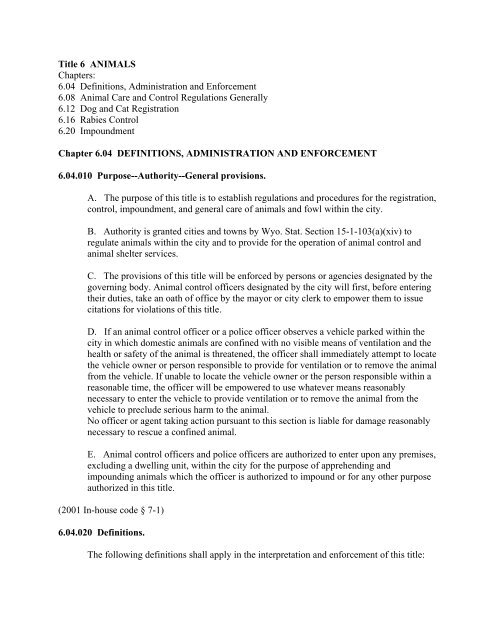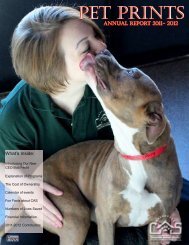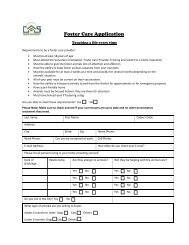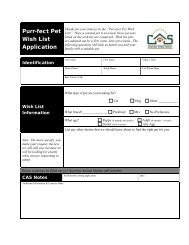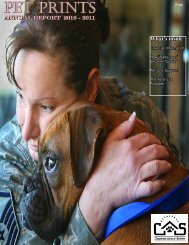City Laws regarding animals - Cheyenne Animal Shelter
City Laws regarding animals - Cheyenne Animal Shelter
City Laws regarding animals - Cheyenne Animal Shelter
You also want an ePaper? Increase the reach of your titles
YUMPU automatically turns print PDFs into web optimized ePapers that Google loves.
subsequent violation by the same owner, regardless of whether or not the same animalwas involved in each violation.(2001 In-house code § 7-30)Chapter 6.08 ANIMAL CARE AND CONTROL REGULATIONS GENERALLY6.08.010 Cruelty to <strong>animals</strong>.A. No owner shall abandon or fail to provide an animal with sufficient, good andwholesome food and water, proper shelter, protection from the weather and veterinarycare when needed to prevent suffering, and with humane care and treatment. Food mustbe free from contamination, wholesome, palatable and of sufficient quantity and nutritivevalue to meet the normal daily requirements for the condition and size of the animal.B. If a shelter with a chain is used as a primary enclosure for a dog kept outdoors, thechain must be placed or attached to avoid entanglement with chains of other dogs or anyother object. A chain should be at least three times the length of the dog as measuredfrom the tip of its nose to the base of its tail, and must allow the dog convenient and safeaccess to shelter.C. No person shall leave a dog or any other animal in an unattended vehicle withoutadequate ventilation or in such a manner as to subject the animal to extreme temperatureswhich adversely affect its health or welfare.D. No person shall establish or promote as an exhibition or cause or permit anydogfight, cockfight, bullfight or other combat between <strong>animals</strong> nor keep or train any bird,dog or other animal with the intent of engaging or using the animal in an exhibition offighting. <strong>Animal</strong>s so kept or trained by persons violating this provision are subject topenalties set out in Wyo. Stat. Section 6-3-203(e).E. No person shall permit, induce or encourage any animal to perform through the useof chemical, mechanical, electrical or manual devices in a manner likely to causephysical injury, suffering or trauma to the animal.F. No person shall willfully kill, maim, inhumanely trap, or disfigure any domestic orwild animal, except as provided for in this title, or administer poison or cause to beingested any foreign object to any animal or expose any poisonous substance with theintent that it will be taken by the animal, except pests of public health importance withina dwelling unit.<strong>Animal</strong> control and police officers have the authority to kill or destroy any wild ordomestic animal in order to avoid an immediate physical threat or injury to humanbeings.(2001 In-house code § 7-4)
6.08.020 Keeping or slaughtering of certain <strong>animals</strong>--Restrictions within city.A. Except as provided within this title, no person may keep or slaughter within the cityany cattle, cows, horses, swine, goats, chickens, ducks, geese, turkeys, guinea fowl,nonhuman primates or other livestock.B. This section shall not apply in areas of the city zoned agricultural; to livestockbrought into the city for purposes of being shipped out of the city; to <strong>animals</strong> brought intothe city to receive veterinary care, or to goats that are being used for weed and pestcontrol purposes by or through the weed and pest control division.C. The keeping of <strong>animals</strong>, birds or fowl, otherwise prohibited by this section, may beallowed for rodeos, fairs, circuses, carnivals, parades and other public exhibitions orentertainment events; provided, that the proper licenses and permits for the event havebeen obtained from the city. Persons desiring to use goats for weed and pest controlpurposes per subsection B of this section must also obtain proper licenses and permits.D. The city/county health officer may issue an order prohibiting the keeping of any<strong>animals</strong>, fowl or bird which poses a health hazard to the general public pursuant to cityordinances, or state and federal laws pertaining to public health.(2001 In-house code § 7-5)6.08.030 <strong>Animal</strong>s running at large prohibited.The owner of an animal must keep the animal under restraint at all times, not permittingit to run at large except on the owner's property. The owner of an animal found to be atlarge shall be responsible for any violation of this section. Upon conviction, the owner ofany animal that is:A. Altered or less than six months of age may be punished as follows:1. First offense: a fifty dollar ($50.00) fine;2. Second offense, within a twelve (12) month period: a seventy-five dollar($75.00) fine and mandatory microchipping and identification of the animal.Upon a second offense, the owner of the animal shall bear the burden of proof andcost <strong>regarding</strong> the animal's alteration and microchipping. Within ten (10) calendardays of redemption, the owner shall provide proof of alteration and microchippingidentification either by certification from a veterinarian, or the owner may havethe animal inspected or scanned at animal control;3. Third and subsequent offenses, within a twelve (12) month period: mandatorycourt appearance, not less than a one hundred dollar ($100.00) fine and up to aseven hundred fifty dollar ($750.00) fine.B. Unaltered may be punished as follows:1. First offense: a seventy-five dollar ($75.00) fine;
2. Second offense, within a twelve (12) month period: a one hundred dollar($100.00) fine. A second offense will result in the mandatory altering andmicrochipping of the animal. Upon a second offense, the owner of the <strong>animals</strong>hall bear the burden of proof and cost <strong>regarding</strong> the animal's alteration andmicrochipping. Within ten (10) calendar days of redemption, the owner shallprovide proof of alteration and microchipping identification either by certificationfrom a veterinarian, or the owner may have the animal inspected or scanned atanimal control;3. Third and subsequent offenses, within a twelve (12) month period: mandatorycourt appearance, not less than a one hundred dollar ($100.00) fine and up to aseven hundred fifty dollar ($750.00) fine.(Ord. 3801 § 3, 2008: 2001 In-house code § 7-6)6.08.040 Owning or keeping dangerous <strong>animals</strong>.No person shall own, keep, harbor or allow to be upon any premises occupied by him orher or under his or her charge or control, any dangerous animal without having the animalproperly secured and muzzled. "Dangerous animal" is defined in Section 6.04.020 as"any animal which constitutes a physical threat to human beings or other <strong>animals</strong>, or ananimal when, unprovoked, bites or attacks a human being. A properly registered animaltrained as a guard, sentry, or police dog may not be considered a dangerous animal."Upon conviction of any person violating this provision, the municipal court may, inaddition to the general penalty provided by city code, order any animal control officer orpolice officer to destroy such animal or ban it from the city, and for that purpose, anyofficer charged with such duty shall have the right to enter upon any premises within thecity.(Ord. 3801 § 4, 2008: Ord. 3675 § 2, 2005; 2001 In-house code § 7-7)6.08.050 Selling of vertebrates.A. No live animal, reptile or bird younger than six weeks in age may be sold inquantities of less than one dozen to one purchaser.B. Live <strong>animals</strong>, reptiles or birds may not be given away as a prize for or as aninducement to enter a place of amusement, or used as an incentive to enter into anybusiness agreement whereby the offer was for the purpose of attracting trade.(2001 In-house code § 7-8)6.08.060 Keeping of wild <strong>animals</strong>.No person shall own any wild animal or exotic pet within the city limits, except that thisrestriction does not apply to the keeping of small cagebirds or aquatic, amphibian or
nonpoisonous reptilian <strong>animals</strong> or small rodents such as hamsters, guinea pigs or gerbilskept solely as pets; nor to any zoological garden, theatrical exhibit, circus, legallyincorporated college, university or school.(2001 In-house code § 7-9)6.08.070 Disturbance of the peace.No owner of an animal within the city shall permit the animal to disturb the peace andquiet of any individual, family or neighborhood by allowing the animal to bark, whine,howl or make any other noise in an excessive, continuous or untimely fashion. If ananimal does so disturb the peace and quiet, its owner shall be deemed guilty of a violationof this section when the owner receives a written warning from the city of a previouscomplaint at least once within the preceding twelve (12) months.(2001 In-house code § 7-10)6.08.090 Quantity of <strong>animals</strong>.A. <strong>Animal</strong>s kept within a dwelling unit are not permitted in quantities of more than fouradult <strong>animals</strong> per dwelling unit. Any dwelling unit or other property maintaining morethan four dogs is considered a kennel and the property must meet zoning requirements.B. More than four dogs of the same litter may be maintained on the premises untilattaining the age of four months.(2001 In-house code § 7-12)6.08.100 Prohibited <strong>animals</strong>--General regulations.The following <strong>animals</strong> shall not be brought into, kept, maintained, offered for sale orbarter, or released within the city: poisonous or venomous biting or injecting species ofamphibian, arachnid or reptile, including snakes. This restriction does not prohibit anycircus or other entertainment organization, an educational facility, or the department ofparks and recreation from keeping such an animal where the animal is securely andhumanely confined.(2001 In-house code § 7-13)6.08.110 Public nuisance--Unlawful.No owner of an animal shall allow it to be or become a public nuisance. Owners violatingthis section shall be subject to the penalty provided within this title or the general penaltyprovided by city code.(2001 In-house code § 7-14)
6.08.120 Vehicular accidents with <strong>animals</strong>.Any motorist, while operating a vehicle, who hits a domestic animal shall stop andimmediately report the incident either to the animal's owner, or, in the event the ownercannot be ascertained and located, to the animal control authority or police department.(2001 In-house code § 7-26)6.08.130 Removal of dead <strong>animals</strong> required.If an animal dies within the city, its owner or person in charge must arrange for theanimal to be buried at a location approved, in advance, by the animal control authority. Ifthe owner or person having charge of the animal neglects to remove the same within ten(10) hours of an animal's death, the animal control authority or police department willarrange for removal at the expense of the owner or persons having charge of the animal,such expense is recoverable by the city through civil action. Whenever the owner orperson having charge of a dead animal cannot be found or ascertained, it is the duty of theanimal control authority to make arrangements for removal and disposal of the animal.(2001 In-house code § 7-27)6.08.140 <strong>Animal</strong> wastes.A. A person owning, keeping, possessing or harboring any animal must remove anddispose of, in a prompt and sanitary manner, feces left by the animal on any publicproperty or any private property not owned or lawfully occupied by such person.B. An animal owner is responsible for keeping his or her property free and clear ofanimal waste to prevent potential harm to the public health, as determined by thecity/county health officer, or his or her designee. If a determination is made that apotentially dangerous situation to the public's health exists, a notice of violation may beissued.C. This section does not apply to persons utilizing a seeing-eye dog or to personsphysically handicapped to such a degree that they are incapable of compliance.D. This section does not apply to owners of <strong>animals</strong> participating in events for which apermit has been issued by the city clerk.(2001 In-house code § 7-28)6.08.150 Housing or exhibiting <strong>animals</strong>.Persons maintaining poultry or <strong>animals</strong> according to Section 6.08.020(B) and (C) of thischapter must keep the same under clean and sanitary conditions. Facilities for housing
and confinement must be thoroughly cleaned at least once every twenty-four (24) hours,or as directed by the city/county health officer. It will be unlawful to permit any decayingfood, or any refuse of any kind, to remain in the facility. The collection and disposition ofrefuse will be in accordance with city ordinances, and it will be unlawful to permit refuseto remain uncovered.(2001 In-house code § 7-29)6.08.160 Carrying an animal on vehicle prohibited--Exception--Penalty--Definitions--Enforcement.A. No person shall carry any animal upon the hood, fender, running board, or otherexternal part of a vehicle or in the open bed of a pickup truck or other vehicle if thevehicle is being operated upon a public road or highway, unless the animal is protectedby framework, carrier or other device sufficient to keep it from falling from the vehicle.This prohibition does not apply to livestock.B. Any person who violates this section is guilty of a misdemeanor.C. Definitions.1. For purposes of this section, "vehicle" means any means of conveyance ortravel which may be lawfully operated or parked upon any public or private way.2. For purposes of this section, "animal" means and includes only living <strong>animals</strong>.D. Enforcement. Any enforcement of this section requiring a traffic stop shall beenforced by the <strong>Cheyenne</strong> police department.(Ord. 3636 § 1, 2005)6.08.170 Owning or keeping a biting animal prohibited--Penalty--Summary impoundment--Fees.A. Any person who owns, possesses, keeps or exercises control over any animal shallprevent the animal from biting or causing any bodily injury to any person or domesticanimal, except that, this section shall not apply to bites inflicted by police service dogs inthe line of duty, nor to owners bitten by their own dog, nor to bites inflicted ontrespassers, nor to bites inflicted as a result of accidental provocation.B. Any animal which bites, attacks, or causes any bodily injury to a human being ordomestic animal, may be summarily and immediately impounded for up to ten (10) daysat the owner's expense. Impoundment is at the discretion of the animal control officer orpolice officer, trained in animal enforcement, that responds as to whether the dog isimpounded or not. Any owner whose animal is impounded shall be afforded anopportunity for a municipal court hearing within not more than ten (10) days ofimpoundment. Prior to court determination of the animal's disposition, the animal shall beassessed to determine if it is rabid, dangerous, physically sound, or may otherwise pose
any threat to the public health, safety and welfare. Assessment shall be at the owner'sexpense.C. Any animal not claimed by the owner within forty-eight (48) hours, shall becomeproperty of the city or its agent, and will be available for adoption to a suitable home, ormay be, by order of the municipal court, humanely euthanized. Owners of reclaimed<strong>animals</strong> shall be subject to and pay a reclamation fee.D. Any person who violates this section shall be issued a must appear citation tomunicipal court and upon conviction, shall be punished by a fine of not more than sevenhundred fifty dollars ($750.00).(Ord. 3801 § 6, 2008; Ord. 3675 § 1, 2005)Chapter 6.12 DOG AND CAT REGISTRATION6.12.010 Registration--Vaccination.A person owning, keeping, harboring or having custody of a dog or cat over four monthsof age must register the animal with the animal control authority through a licensed stateveterinarian, or at the office of the animal control authority. A certificate of vaccinationconstitutes the registration form, which is considered complete when a copy has beenreceived at the animal control authority office. Ownership of the dog or cat vaccinatedwill be presumed to be that individual listed as owner on the certificate.(2001 In-house code § 7-15(a))6.12.020 Rabies tag.The rabies tag, which is provided at the time of rabies vaccination, serves as theregistration tag and must be displayed on a chain, collar or harness attached to the animal.The registration and rabies tag are valid for the period of the rabies vaccination or oneyear, whichever is shorter.No person, other than the owner or an animal control officer, shall remove the collar,harness or registration tag from an animal. The registration and rabies tag are valid onlyfor the animal for which it is issued.(2001 In-house code § 7-15(b))6.12.030 Record.The animal control authority will maintain a public record of dogs and cats registered.(2001 In-house code § 7-15(c))Chapter 6.16 RABIES CONTROL
6.16.010 Exemptions.Hospitals, clinics and other premises operated by a licensed veterinarian for animal careand treatment are exempt from the provisions of this title pertaining to rabies control,except where expressly stated.(2001 In-house code § 7-16)6.16.020 Rabies vaccination required.A. All dogs and cats, which are four months of age or older, must be vaccinated againstrabies. All dogs and cats vaccinated at four months of age or older must be re-vaccinatedat one year of age and thereafter at intervals recommended by current state veterinarystandards. If any dog or cat does not have a current rabies vaccination tag, or specificallyfor dogs, a current license tag, affixed to its collar or harness, the animal's owner will bepresumed to have violated the provisions of this title.(2001 In-house code § 7-17)6.16.030 Reporting animal bites--Rabies quarantine.A. Any person who knows that an animal has bitten a human being shall immediatelyreport the incident to the animal control authority or police department, together with thename and address of the person bitten, if known.B. If an animal is suspected of having rabies or if an animal has bitten a person, theanimal must be confined for a period of at least ten (10) days by a leash, chain or cage atthe animal shelter, veterinary hospital or at a location approved by the city/county healthofficer, or their designee, or destroyed with the animal's corpse submitted to an approvedlaboratory for rabies analysis.C. No animal held for observation on suspicion of rabies will be released until theobservation period is over. Upon proof of current rabies vaccination, the animal may bereleased into quarantine at the owner's residence at the discretion of the animal controlauthority.D. If an animal has been bitten by another animal suspected of having rabies, the ownerof the bitten animal must report the incident to the animal control authority or the policedepartment.E. The animal control authority may remove an animal suspected of rabies, or of beingexposed to rabies, from the owner's premises to a veterinary hospital, at the owner'sexpense to be paid in advance, for observation during the standard incubation periodestablished by the State Health Department for the particular species of animal. Theowner may elect to have the animal destroyed. Upon proof of previous vaccination,
into the quarantine area without permission of the animal control authority. In the eventthat additional cases of rabies occur during the quarantine period, the time frame may beextended as determined by the animal control authority.B. During the quarantine period and as long afterward as deemed necessary to preventthe spread of rabies, the animal control authority may require that all <strong>animals</strong> threemonths of age or older within the quarantine area be vaccinated against rabies. Allvaccinated <strong>animals</strong> shall be kept under restraint for thirty (30) days after vaccination.During the quarantine period, the animal control authority is authorized to provide for aprogram of mass immunization by the establishment of temporary emergency caninerabies vaccination clinics.C. No animal which has been impounded by reason of its being a stray and unclaimedby an owner, may be adopted from the animal shelter during the period of a rabiesquarantine, except by special authorization of the animal control authority.D. Licensed veterinarians must report any animal considered to be a rabies suspect tothe animal control authority.(2001 In-house code § 7-20)Chapter 6.20 IMPOUNDMENT6.20.010 Designation of animal shelter.The city may designate or operate a facility for holding of <strong>animals</strong>, including dogs andcats, and enter into a cooperative agreement with other jurisdictions for the operation ofsuch an animal shelter facility.(2001 In-house code § 7-21)6.20.020 <strong>Animal</strong> impoundment.A. At large, maltreated, rabid, dangerous and/or public nuisance <strong>animals</strong> may be takenby animal control authorities and impounded in an animal shelter, confined in a humanemanner. <strong>Animal</strong>s at large which are not maltreated, rabid or dangerous and which arewearing current rabies tags may be returned to the owner upon proof of ownership. Theowner may be issued a citation for a violation of this title.B. Impounded <strong>animals</strong> which are seriously injured or ill and have no current rabies tagmay be destroyed.C. If the animal is seriously injured or ill and is wearing a current rabies identificationtag, a diligent and reasonable effort to locate and inform the owner will be made. If theowner is unable to be located, the animal may, upon recommendation of a veterinarian,be destroyed.
D. Notice of impoundment of an animal wearing a current registration or rabies tag orother identification will be attempted within thirty-six (36) hours of impoundment by theanimal control authority to the owner either by telephone or in person at the addressnoted on the registration, identification or rabies document. When notice cannot be madeto an owner within thirty-six (36) hours of impoundment, or when the animal isunidentified, written notice by the animal control authority will be posted at the <strong>animals</strong>helter within twelve (12) hours of impoundment, giving a summary description of theanimal held. Notice will be mailed to the owner's residence, if known.E. Any animal not claimed by its owner within two working days will become theproperty of the animal shelter, and will be available for adoption in a suitable home, orhumanely euthanized.(Ord. 3801 § 7, 2008; 2001 In-house code § 7-22)6.20.030 Release of impounded <strong>animals</strong>.A. An owner reclaiming an impounded animal must pay the following fees:1. Any altered animal: thirty dollars ($30.00);2. Any unaltered animal, initial owner reclaim: fifty dollars ($50.00);3. Subsequent reclaiming by owner of any unaltered animal, within a twelve (12)month period: minimum one hundred dollars ($100.00);4. Reduction of fee by five dollars if the animal is wearing a rabies oridentification tag or other acceptable form of identification listing the owner'sname and current address.B. An owner reclaiming an impounded animal which does not have a current rabies tag,prior to the animal's release, must submit proof of current rabies vaccination certificatefor the animal issued by a licensed veterinarian, or, in lieu thereof, the owner may submita cash deposit of twenty-five dollars ($25.00) with the animal shelter to be refunded uponthe owner submitting proof, within seventy-two (72) hours of vaccination and license.Failure to comply may result in reimpoundment of the animal, forfeiture of the deposit,and disposition in accordance with Section 6.20.040 of this chapter.C. Owners of any reclaimed impounded animal may, in addition to the above fees, besubject to penalty as provided by this title or the city code.(2001 In-house code § 7-23)6.20.040 Disposition of unredeemed <strong>animals</strong>.If an impounded animal is not claimed or redeemed from the animal shelter in the mannerand time provided in this chapter, it will become the property of the animal controlauthority and may be eligible for adoption either by the city or by another agency. If theanimal is not adopted within five days, the animal may be destroyed.
(2001 In-house code § 7-24)6.20.050 Sterilization.Dogs and cats adopted from the animal shelter must be sterilized. If an animal is notsterilized at the time of adoption, the proposed owner must deposit twenty-five dollars($25.00) with the adopting agency which will be refunded upon submission of proof ofsterilization. The adopter must present proof of sterilization within sixty (60) days fromadoption, provided, however, the requirement will be waived upon presentation of acertificate from a licensed veterinarian stating the animal is too young for sterilizationduring the prescribed period. The certificate will state the earliest time the animal maysafely be sterilized, at which time the animal will be sterilized and the adopter willpresent to the adopting agency said proof of sterilization. Failure by the adopter to submitproof of sterilization will be deemed a violation of this section, punishable, uponconviction, of a fine of not less than fifty dollars ($50.00).(2001 In-house code § 7-25)


